Overview
Tropical Storm Nestor made landfall in the Florida Panhandle during the late morning hours on Saturday, October 19th. Nestor became extratropical shortly after making landfall as it tracked to the northeast. Nestor continued to track to the northeast rather quickly, as its center moved into southeast North Carolina just before sunrise on 10/20. A large area of rain (mainly north/northeast of the center) overspread the Wakefield CWA from SW to NE during the morning hours on 10/20. 8 AM temperatures were in the mid-upper 50s across central VA, with upper 60s over far SE VA/NE NC. As the center of Nestor moved into NE NC by the late morning hours, temperatures jumped into the low-mid 70s across NE NC (as our NE NC counties were now in the warm sector after the steady rain moved to their north). Meanwhile, rain continued across much of Virginia and Maryland through the morning. Rainfall rates were generally in the 0.2 to 0.5 inch/hour range. However, there was one band of rain that moved across south-central/southeast VA during the morning hours that (briefly) produced rates of 1-1.5 inches/hour. This was associated with a band of frontogenesis that was most prominent in the 925-700 mb layer. The low center eventually tracked through SE VA (and onto southern portions of the VA Eastern Shore) during the afternoon hours on Sunday (10-21). As this happened, rain tapered off across the area from W to E. However, as the low moved over the Eastern Shore, some low-topped convection developed and moved across Accomack County, producing a quick 1.5" of rain from 2:30-4 PM (after 3" of rain was already reported). In total, rainfall amounts were 1-3" in most areas, with 3-5" from parts of SE VA to the Lower Eastern Shore. Luckily, only minor flooding was reported with this event (despite rainfall totals of 4-4.5" in some areas). This was due to the fact that antecedent conditions were quite dry (a large part of the area was in a moderate to locally severe drought), due to a short-term (1-2 month) deficit in rainfall.
As the low pulled offshore during the late evening-overnight hours, north winds increased on the back side of the system...especially over the Chesapeake Bay/Atlantic Ocean. The combination of cold air advection (925 mb temperatures dropped into the 10-12°C range), strong 950-900 mb winds, and relatively warm water allowed for a 4-6 hour period of frequent wind gusts of 40-50 mph over the bay/ocean. Winds slowly subsided overnight as the low continued to move offshore (although wind restrictions were in place at the Chesapeake Bay Bridge Tunnel through 8-9 AM the next morning).
Storm Total Rainfall:
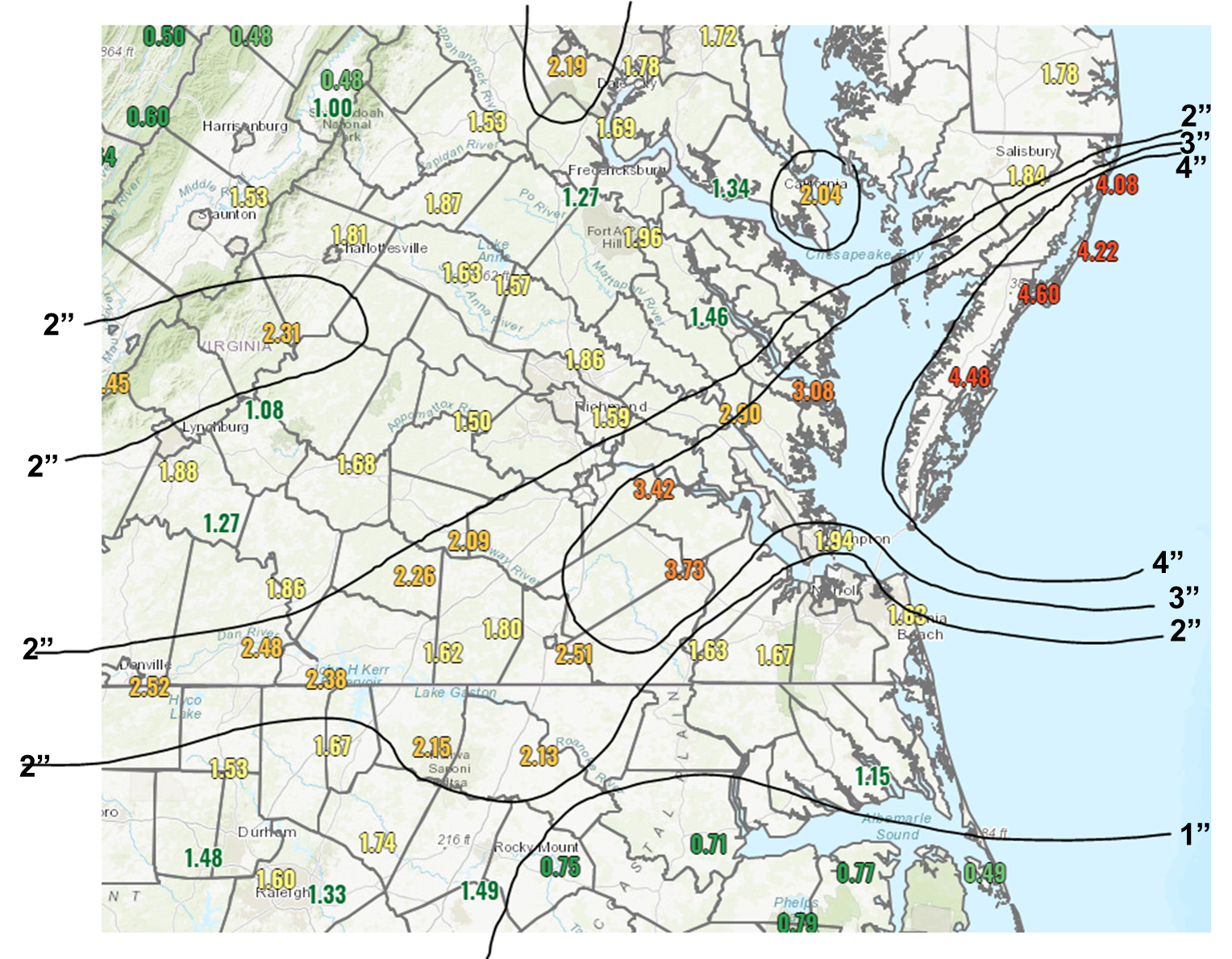
Radar
Header
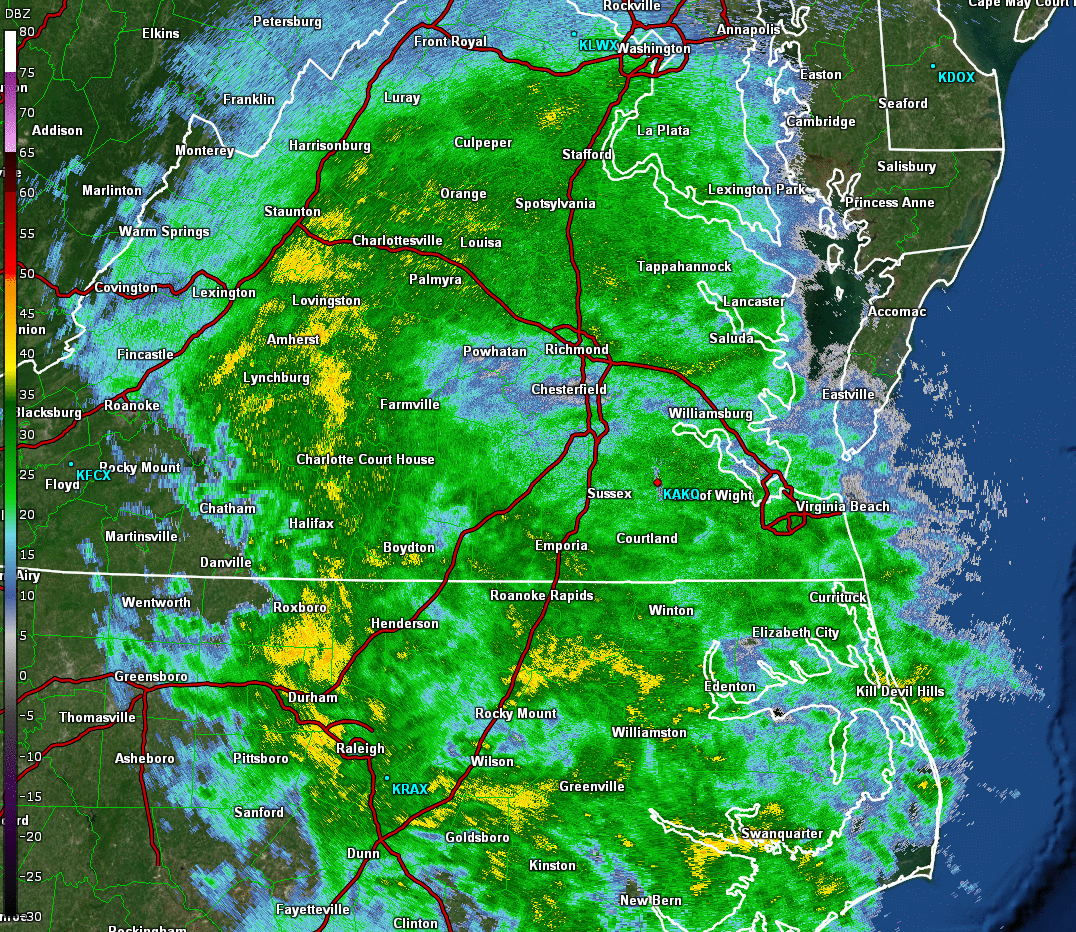 |
| Loop of 0.5° Base Reflectivity from ~5 AM-5 PM on 10/20 in ~30 minute increments |
Wind Reports
...HIGHEST WIND REPORTS... Location Speed Time/Date Provider ...Maryland... ...Dorchester County... Cambridge-Dorch 35 MPH 0300 PM 10/20 AWOS Cambridge, MD 34 MPH 0254 PM 10/20 NOS-NWLON Bucktown 34 MPH 0255 PM 10/20 AWS Blackwater 33 MPH 0326 PM 10/20 RAWS NEAVITT 30 MPH 0332 PM 10/20 CWOP ...Somerset County... Crisfield 25 MPH 1000 PM 10/20 AWS ...Wicomico County... Salisbury Wicomico Airport 39 MPH 0604 PM 10/20 ASOS ...Worcester County... Assateague Island 43 MPH 0940 PM 10/20 RAWS Ocean City 43 MPH 0711 PM 10/20 ASOS 1 SSW Ocean City 41 MPH 0700 PM 10/20 AWS ...North Carolina... ...Camden County... Shiloh 36 MPH 0100 PM 10/20 CWOP ...Chowan County... Edenton 29 MPH 1155 AM 10/20 AWOS ...Currituck County... Corolla 43 MPH 1200 PM 10/20 CWOP 3.0 E Knotts Island (WEATHER 38 MPH 1250 PM 10/20 MESOWEST 1.6 NW Moyock (WEATHERSTEM) 37 MPH 1030 AM 10/20 MESOWEST 3.4 S Corolla (WEATHERSTEM) 36 MPH 1100 AM 10/20 MESOWEST 0.5 E Jarvisburg (WEATHERSTE 36 MPH 1240 PM 10/20 MESOWEST Currituck 35 MPH 1055 AM 10/20 AWOS ...Northampton County... Conway 37 MPH 1140 AM 10/20 CWOP ...Pasquotank County... Elizabeth City 36 MPH 0113 PM 10/20 RAWS Elizabeth City Airport 36 MPH 1031 AM 10/20 ASOS ...Perquimans County... Chapanoke 26 MPH 0125 PM 10/20 CWOP ...Virginia... ...Accomack County... Tangier Sound Light 46 MPH 1004 PM 10/20 WXFLOW Onancock 44 MPH 0940 PM 10/20 WXFLOW Wallops Island 37 MPH 0746 PM 10/20 ASOS Wachapreague 32 MPH 1218 PM 10/20 WXFLOW Melfa Accomack 28 MPH 0955 PM 10/20 AWOS Wachapreague, VA 28 MPH 1218 PM 10/20 NOS-NWLON Parksley 26 MPH 1001 PM 10/20 CWOP ...Brunswick County... South Hill 25 MPH 0435 PM 10/20 AWOS ...Caroline County... Fort A.P Hill 25 MPH 0533 PM 10/20 RAWS ...City of Chesapeake County... Fentress Naval 38 MPH 1146 AM 10/20 AWOS Money Point 32 MPH 1212 PM 10/20 NOS-PORTS Chesapeake 28 MPH 1015 AM 10/20 AWOS ...City of Colonial Heights County... City Of Colonial Heights 25 MPH 0746 PM 10/20 CWOP ...City of Hampton County... Langley AFB 30 MPH 0928 PM 10/20 AWOS ...City of Newport News County... Newport News 30 MPH 0654 PM 10/20 ASOS ...City of Norfolk County... Norfolk Intl Airport 39 MPH 1141 AM 10/20 ASOS Norfolk NAS 37 MPH 1247 PM 10/20 AWOS Lafayette River 34 MPH 1110 AM 10/20 WXFLOW Norfolk 27 MPH 1246 PM 10/20 CWOP ...City of Poquoson County... Poquoson 35 MPH 1011 PM 10/20 WXFLOW ...City of Portsmouth County... South Craney Island 33 MPH 1206 PM 10/20 NOS-PORTS Portsmouth 26 MPH 0153 PM 10/20 CWOP ...City of Suffolk County... Suffolk 28 MPH 0716 PM 10/20 CWOP ...City of Virginia Beach County... Cape Henry 51 MPH 0921 PM 10/20 WXFLOW Oceana NAS Souce 40 MPH 1233 PM 10/20 AWOS Back Bay 33 MPH 1227 PM 10/20 RAWS Virginia Beach 30 MPH 1010 PM 10/20 CWOP Creeds 29 MPH 1244 PM 10/20 WXFLOW ...Dinwiddie County... Dinwiddie 27 MPH 0423 PM 10/20 CWOP Petersburg 25 MPH 0615 PM 10/20 AWOS ...Essex County... Dunnsville 27 MPH 1048 AM 10/20 CWOP Tappahannock 25 MPH 0655 PM 10/20 AWOS ...Henrico County... KRIC Richmond Intl Airport 31 MPH 0625 PM 10/20 ASOS ...King and Queen County... West Point 35 MPH 1235 PM 10/20 AWOS ...Louisa County... Mineral 27 MPH 1005 AM 10/20 CWOP ...Lunenburg County... 2 WSW Kenbridge 36 MPH 1005 AM 10/20 CWOP Kenbridge 25 MPH 0555 PM 10/20 AWOS ...Mathews County... New Point Comfort 36 MPH 1135 AM 10/20 WXFLOW North 29 MPH 0748 PM 10/20 CWOP ...Mecklenburg County... Boydton 28 MPH 1147 AM 10/20 CWOP ...Middlesex County... Saluda 31 MPH 1015 PM 10/20 AWOS ...Northampton County... Kiptopeke, VA 44 MPH 0848 PM 10/20 NOS-NWLON ...Northumberland County... Lewisetta, VA 37 MPH 0112 PM 10/20 NOS-NWLON ...Nottoway County... Blackstone Fort 26 MPH 0315 PM 10/20 AWOS ...York County... Seaford 26 MPH 1111 AM 10/20 CWOP
...Virginia... Rappahannock Light 51 MPH 0906 PM 10/20 NOS-PORTS Cape Henry, VA 49 MPH 0948 PM 10/20 NOS-PORTS 8 NW Cape Henry 47 MPH 0924 PM 10/20 NDBC Plantation Flats 47 MPH 0943 PM 10/20 WXFLOW Silver Beach 45 MPH 0914 PM 10/20 WXFLOW 6 NW Cape Henry 43 MPH 0950 PM 10/20 NDBC Willoughby Deguassing Statio 41 MPH 1254 PM 10/20 NOS-PORTS Sandbridge 41 MPH 0104 PM 10/20 WXFLOW York River East Rear Range L 40 MPH 1136 AM 10/20 NOS-PORTS 5 NE Plum Tree Island Refuge 38 MPH 1130 AM 10/20 NDBC Middle Ground Lighthouse 37 MPH 1251 PM 10/20 WXFLOW Thimble Shoals 37 MPH 0959 PM 10/20 WXFLOW 2 E Stingray Point 36 MPH 0912 PM 10/20 NDBC Hampton Flats 36 MPH 1202 PM 10/20 WXFLOW Deltaville 35 MPH 0957 PM 10/20 WXFLOW Dominion Terminal 33 MPH 1006 AM 10/20 NOS-PORTS Poquoson River Light 33 MPH 0957 PM 10/20 WXFLOW Machipongo 32 MPH 1052 AM 10/20 CWOP Yorktown USCG Training Cente 31 MPH 0918 PM 10/20 NOS-NWLON
Rainfall Reports
Location Amount Time/Date Lat/Lon ...Maryland... ...Dorchester County... Blackwater 1.78 in 0526 PM 10/20 38.45N/76.09W Cambridge 1.63 in 0600 PM 10/20 38.58N/76.09W NEAVITT 1.32 in 0601 PM 10/20 38.40N/76.10W ...Somerset County... Princess Anne 2.56 in 0604 PM 10/20 38.20N/75.69W Crisfield 1.69 in 0603 PM 10/20 37.98N/75.86W ...Wicomico County... Powellville 2.77 in 0548 PM 10/20 38.36N/75.43W Salisbury Wicomico Airport 1.81 in 0602 PM 10/20 38.33N/75.50W ...Worcester County... Assateague Island 4.00 in 0540 PM 10/20 38.08N/75.20W Ocean City 3.79 in 0553 PM 10/20 38.32N/75.12W Berlin 3.25 in 0555 PM 10/20 38.32N/75.12W ...North Carolina... ...Bertie County... Windsor 8.8 NW 1.92 in 1140 AM 10/20 36.08N/77.06W Aulander 0.6 NE 1.00 in 1201 PM 10/20 36.24N/77.11W ...Camden County... South Mills 0.87 in 0603 PM 10/20 36.45N/76.30W ...Currituck County... Currituck 0.92 in 0555 PM 10/20 36.40N/76.02W Corolla 0.74 in 0602 PM 10/20 36.30N/75.80W ...Northampton County... Henrico 2.31 in 0601 PM 10/20 36.54N/77.86W Conway 2.05 in 0600 PM 10/20 36.43N/77.23W ...Pasquotank County... Elizabeth City 1.31 in 0603 PM 10/20 36.30N/76.27W Elizabeth City Airport 1.14 in 0600 PM 10/20 36.27N/76.18W ...Perquimans County... Hertford 1.09 in 0603 PM 10/20 36.17N/76.30W ...Virginia... ...Accomack County... Wallops Island 4.47 in 0554 PM 10/20 37.93N/75.47W Parksley 4.43 in 0602 PM 10/20 37.73N/75.61W Melfa Accomack 3.90 in 0555 PM 10/20 37.63N/75.77W Chincoteague 3.33 in 0603 PM 10/20 37.93N/75.38W ...Amelia County... Jetersville 3.6 W 1.84 in 0800 AM 10/20 37.30N/78.16W Amelia Courthouse 1.65 in 0605 PM 10/20 37.34N/77.98W ...Brunswick County... Lawrenceville 1.80 in 0555 PM 10/20 36.78N/77.80W South Hill Meckl 1.62 in 0555 PM 10/20 36.68N/78.03W ...Caroline County... Faph_north1 2.14 in 0526 PM 10/20 38.19N/77.30W Faph_eodtc 1.93 in 0532 PM 10/20 38.13N/77.18W Bowling Green 1.59 in 0604 PM 10/20 38.04N/77.34W ...Chesterfield County... Matoaca 2.16 in 0601 PM 10/20 37.29N/77.48W Midlothian 1.96 in 0605 PM 10/20 37.55N/77.66W Bon Air 1.82 in 0604 PM 10/20 37.53N/77.56W Winterpock 1.56 in 0555 PM 10/20 37.34N/77.64W 5 NNE Winterpock 1.30 in 0604 PM 10/20 37.41N/77.68W ...City of Chesapeake County... 7.4 NW Horseshoe 4.00 in 0500 PM 10/20 36.56N/76.44W Fentress Naval 1.24 in 0556 PM 10/20 36.70N/76.13W ...City of Colonial Heights County... City Of Colonial Heights 2.16 in 0600 PM 10/20 37.25N/77.41W ...City of Hampton County... Langley AFB Hamp 1.92 in 0538 PM 10/20 37.07N/76.37W Hampton 1.78 in 0602 PM 10/20 37.09N/76.42W ...City of Hopewell County... 1 NE Hopewell 2.55 in 0605 PM 10/20 37.30N/77.29W ...City of Newport News County... Newport News 2.38 in 0554 PM 10/20 37.13N/76.50W ...City of Norfolk County... Norfolk Intl Airport 1.83 in 0551 PM 10/20 36.90N/76.20W Norfolk NAS Cham 1.71 in 0559 PM 10/20 36.92N/76.27W ...City of Portsmouth County... Portsmouth 1.55 in 0603 PM 10/20 36.80N/76.33W ...City of Richmond County... 2.5 W East Highland Park (IF 1.69 in 0123 PM 10/20 37.56N/77.42W ...City of Suffolk County... Gdr 1.71 in 0526 PM 10/20 36.61N/76.55W Suffolk 1.66 in 0600 PM 10/20 36.87N/76.50W ...City of Virginia Beach County... Virginia Beach 1.78 in 0601 PM 10/20 36.82N/76.20W Oceana NAS Souce 1.59 in 0556 PM 10/20 36.82N/76.02W North Port 1.59 in 0600 PM 10/20 36.84N/75.99W Back Bay 1.57 in 0527 PM 10/20 36.67N/75.92W ...City of Williamsburg County... Williamsburg 2.01 in 0605 PM 10/20 37.28N/76.71W ...Cumberland County... Farmville 1.68 in 0555 PM 10/20 37.35N/78.42W 1.2 E Reeds 1.60 in 1000 AM 10/20 37.33N/78.38W Farmville 1.60 in 0602 PM 10/20 37.42N/78.35W ...Dinwiddie County... Dinwiddie 2.79 in 0603 PM 10/20 36.98N/77.54W Churchroad 2.56 in 0601 PM 10/20 37.13N/77.69W ...Essex County... Dunnsville 1.75 in 0603 PM 10/20 37.89N/76.81W Tappahannock 1.46 in 0555 PM 10/20 37.87N/76.90W ...Fluvanna County... Scottsville 1.32 in 0600 PM 10/20 37.74N/78.40W 1 S Union Mills 1.32 in 0604 PM 10/20 37.92N/78.31W ...Gloucester County... Hayes 2.32 in 0605 PM 10/20 37.27N/76.43W ...Goochland County... Kents Store 1.64 in 0602 PM 10/20 37.87N/78.05W ...Greensville County... Purdy 3.07 in 0604 PM 10/20 36.80N/77.60W Emporia 2.24 in 0555 PM 10/20 36.68N/77.48W ...Hanover County... Richmond Hanover 1.85 in 0554 PM 10/20 37.70N/77.43W Ashland 1.67 in 0600 PM 10/20 37.75N/77.48W Montpelier 1.50 in 0600 PM 10/20 37.81N/77.64W ...Henrico County... Richmond 1.67 in 0605 PM 10/20 37.60N/77.58W Glen Allen 1.66 in 0605 PM 10/20 37.69N/77.59W Richmond Intl Airport 1.59 in 0554 PM 10/20 37.52N/77.32W 2 WNW Tuckahoe 1.47 in 0604 PM 10/20 37.60N/77.63W 1 NW Lakeside 1.46 in 0605 PM 10/20 37.63N/77.48W ...Isle of Wight County... Smithfield 1.76 in 0603 PM 10/20 36.99N/76.74W Carrollton 1.67 in 0558 PM 10/20 36.93N/76.53W Franklin J B Ros 1.63 in 0555 PM 10/20 36.70N/76.90W ...James City County... Fords Colony 3.89 in 0358 PM 10/20 37.30N/76.75W Williamsburg 2.1 WNW 1.44 in 1007 AM 10/20 37.28N/76.74W ...King William County... West Point 3.08 in 0600 PM 10/20 37.57N/76.80W ...King and Queen County... West Point 2.89 in 0555 PM 10/20 37.52N/76.77W ...Lancaster County... Kilmarnock 3.16 in 0604 PM 10/20 37.71N/76.38W Mollusk 2.83 in 0601 PM 10/20 37.71N/76.53W Lancaster 2.71 in 0601 PM 10/20 37.73N/76.51W ...Louisa County... Troy 2.27 in 0602 PM 10/20 38.01N/78.25W Louisa 1.96 in 0552 PM 10/20 38.04N/78.01W Mineral 1.93 in 0605 PM 10/20 38.02N/77.92W Troy 1.64 in 0600 PM 10/20 38.00N/78.24W Bumpass 1.56 in 0555 PM 10/20 37.97N/77.75W Louisa 1.55 in 0555 PM 10/20 38.02N/77.97W ...Lunenburg County... Kenbridge 2.26 in 0555 PM 10/20 36.95N/78.18W 2 WSW Kenbridge 2.11 in 0601 PM 10/20 36.95N/78.17W Victoria 0.9 N 1.47 in 0700 AM 10/20 37.01N/78.22W ...Mathews County... 1 NNW Mathews 2.33 in 0605 PM 10/20 37.45N/76.33W North 2.24 in 0603 PM 10/20 37.45N/76.45W ...Mecklenburg County... John H Kerr Dam 3.10 in 0345 PM 10/20 36.60N/78.30W Chase City 2.67 in 0555 PM 10/20 36.78N/78.50W Boydton 2.38 in 0602 PM 10/20 36.73N/78.36W Clarksville 1.63 in 0700 AM 10/20 36.62N/78.57W ...Middlesex County... Hartfield 4.16 in 0601 PM 10/20 37.56N/76.51W Remlik 3.55 in 0555 PM 10/20 37.68N/76.62W Saluda 3.08 in 0555 PM 10/20 37.60N/76.45W ...Northampton County... Oyster 2.28 in 0200 PM 10/20 37.29N/75.93W Willis Wharf 2.01 in 0605 PM 10/20 37.52N/75.82W ...Northumberland County... Kilmarnock 2.62 in 0600 PM 10/20 37.70N/76.31W ...Nottoway County... Crewe 2.71 in 0602 PM 10/20 37.18N/78.13W Blackstone Fort 0.94 in 0555 PM 10/20 37.07N/77.95W ...Powhatan County... Powhatan 1.50 in 0602 PM 10/20 37.50N/77.93W ...Prince Edward County... Pamplin 1.80 in 0600 PM 10/20 37.27N/78.63W Farmville 1.30 in 0605 PM 10/20 37.30N/78.39W ...Prince George County... 2 WSW Garysville 1.78 in 0605 PM 10/20 37.23N/77.20W ...Richmond County... 1 NNE Kennard 2.78 in 0604 PM 10/20 37.94N/76.74W ...Southampton County... Drewryville 2.3 SW 2.32 in 0935 AM 10/20 36.69N/77.34W 2 WSW Courtland 1.65 in 0603 PM 10/20 36.70N/77.10W ...Surry County... Surry 2.94 in 0603 PM 10/20 37.17N/76.81W ...Sussex County... Wakefield NWS 3.73 in 0354 PM 10/20 36.98N/77.00W ...York County... Williamsburg 3.85 in 0601 PM 10/20 37.35N/76.70W Seaford 2.57 in 0551 PM 10/20 37.19N/76.43W 1 NNE Hornsbyville 2.02 in 0604 PM 10/20 37.22N/76.46W
Environment
Synoptic Summary.
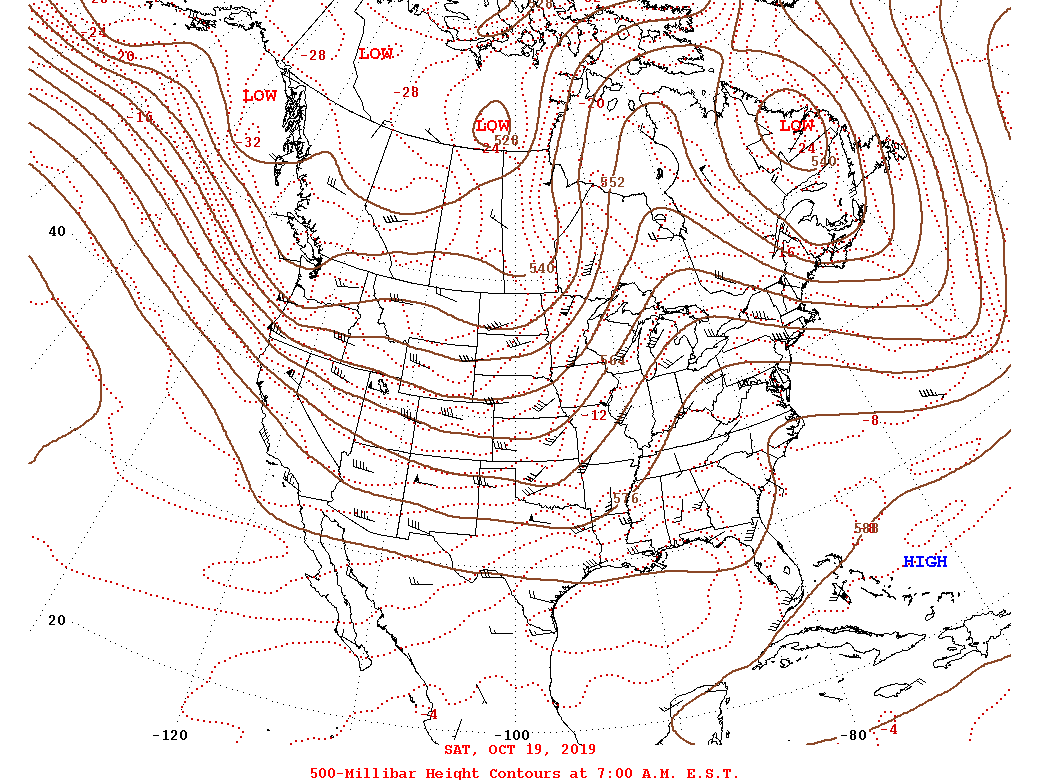 |
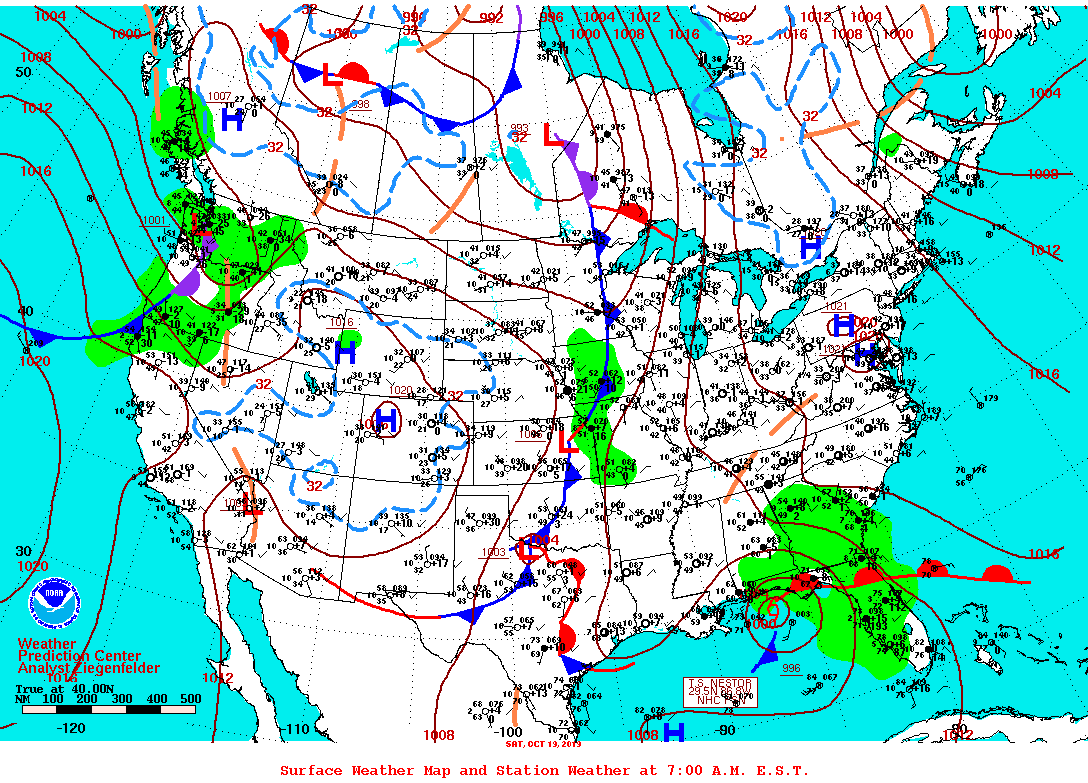 |
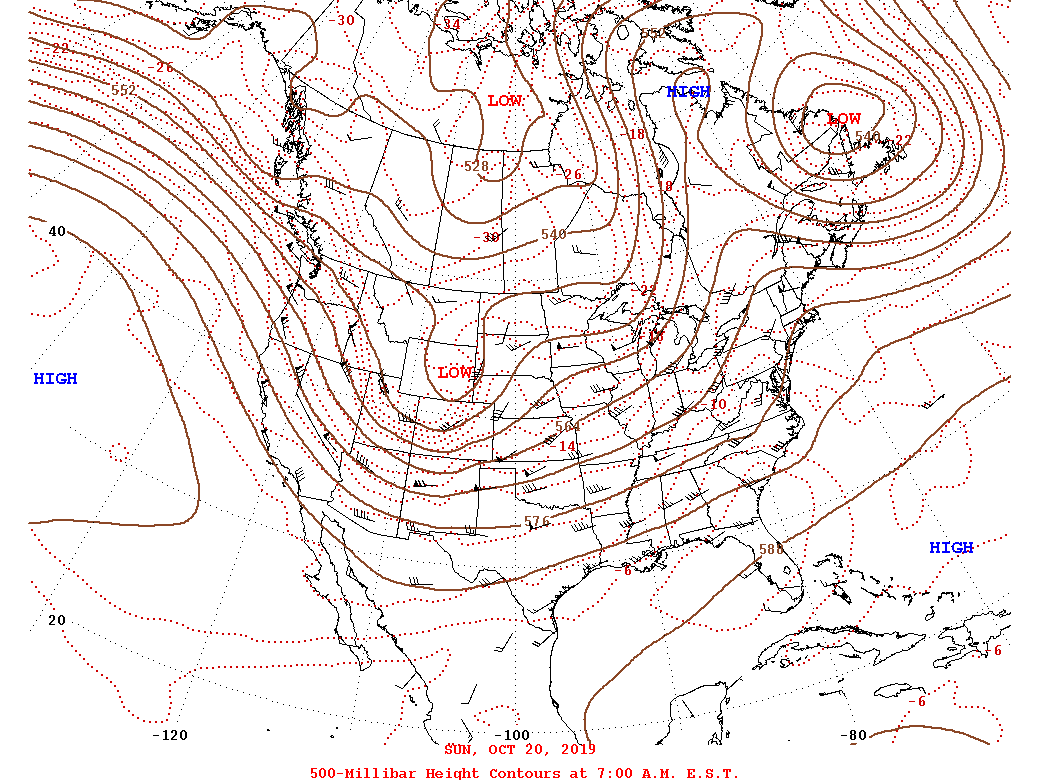 |
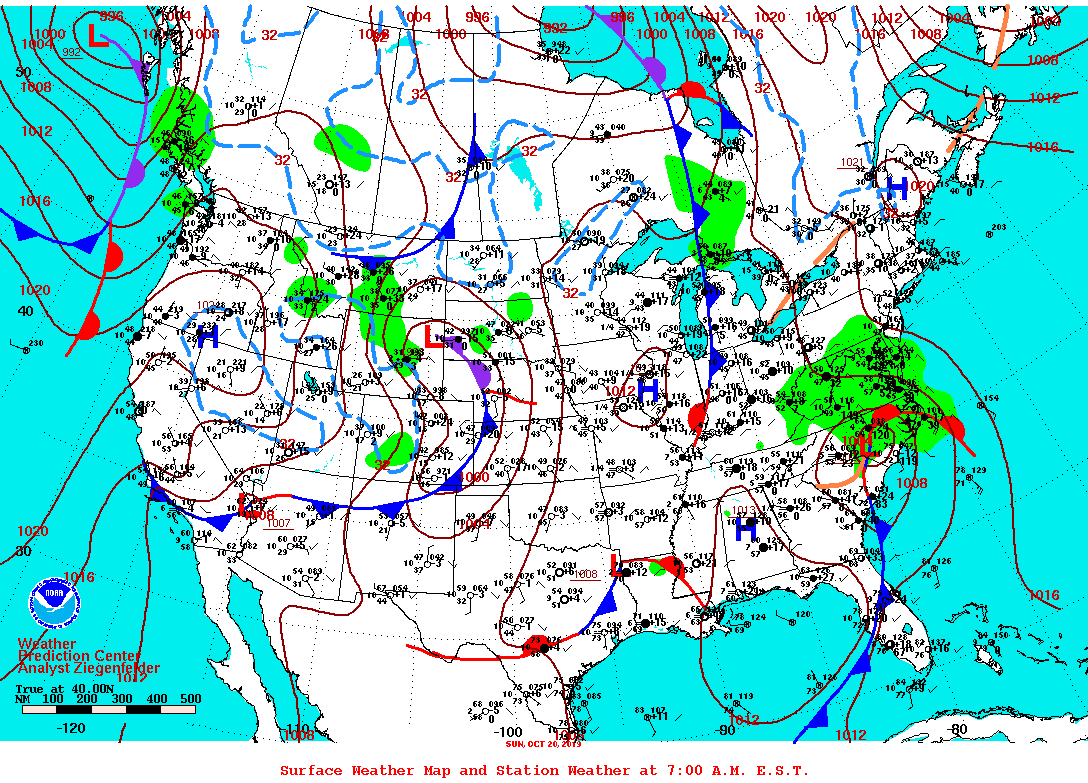 |
| 12z/8 AM 10-19 500 mb Analysis | 12z/8 AM 10-19 WPC Surface Analysis | 12z/8 AM 10-20 500 mb Analysis | 12z/8 AM 10-20 WPC Surface Analysis |
Regional Surface Analysis.
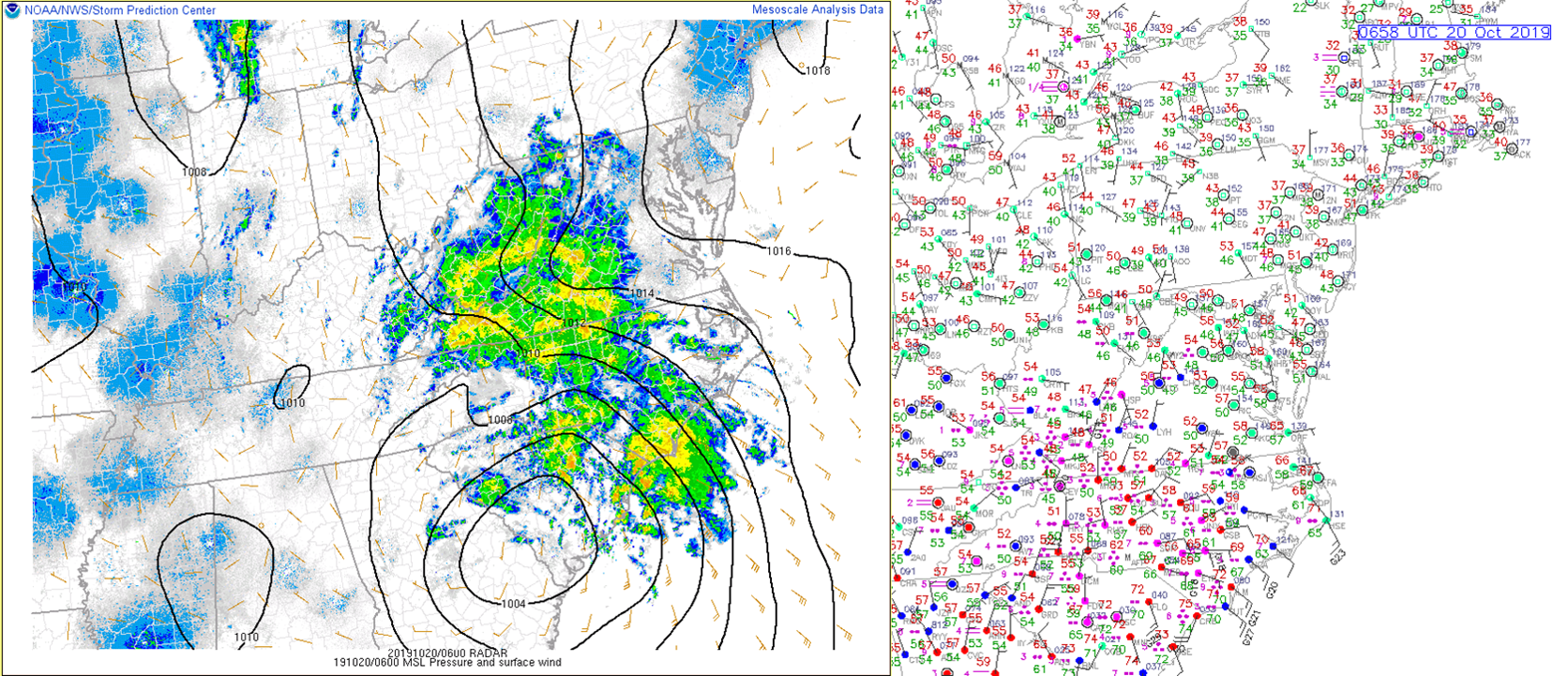 |
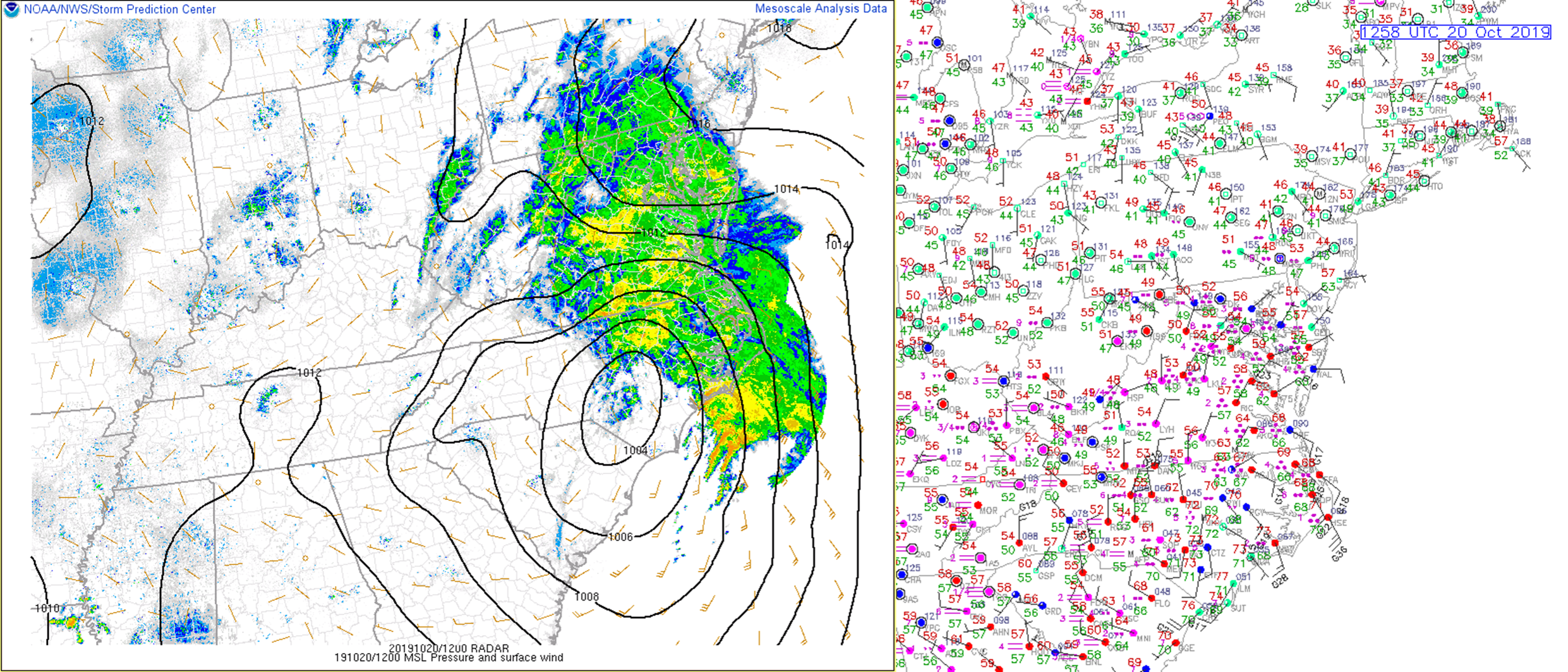 |
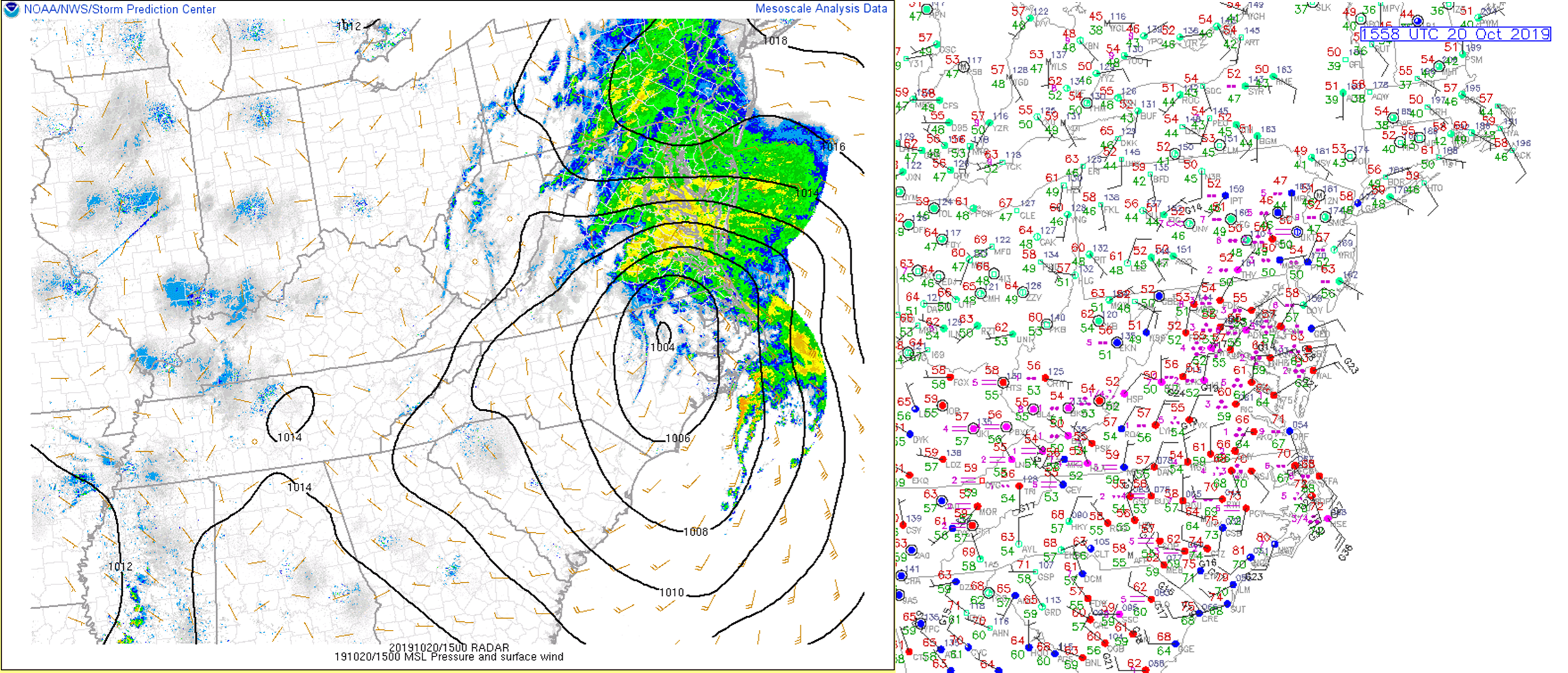 |
| 06z/2 AM 10-20 Surface Analysis + Observations | 12z/8 AM 10-20 Surface Analysis + Observations | 15z/11 AM 10-20 Surface Analysis + Observations |
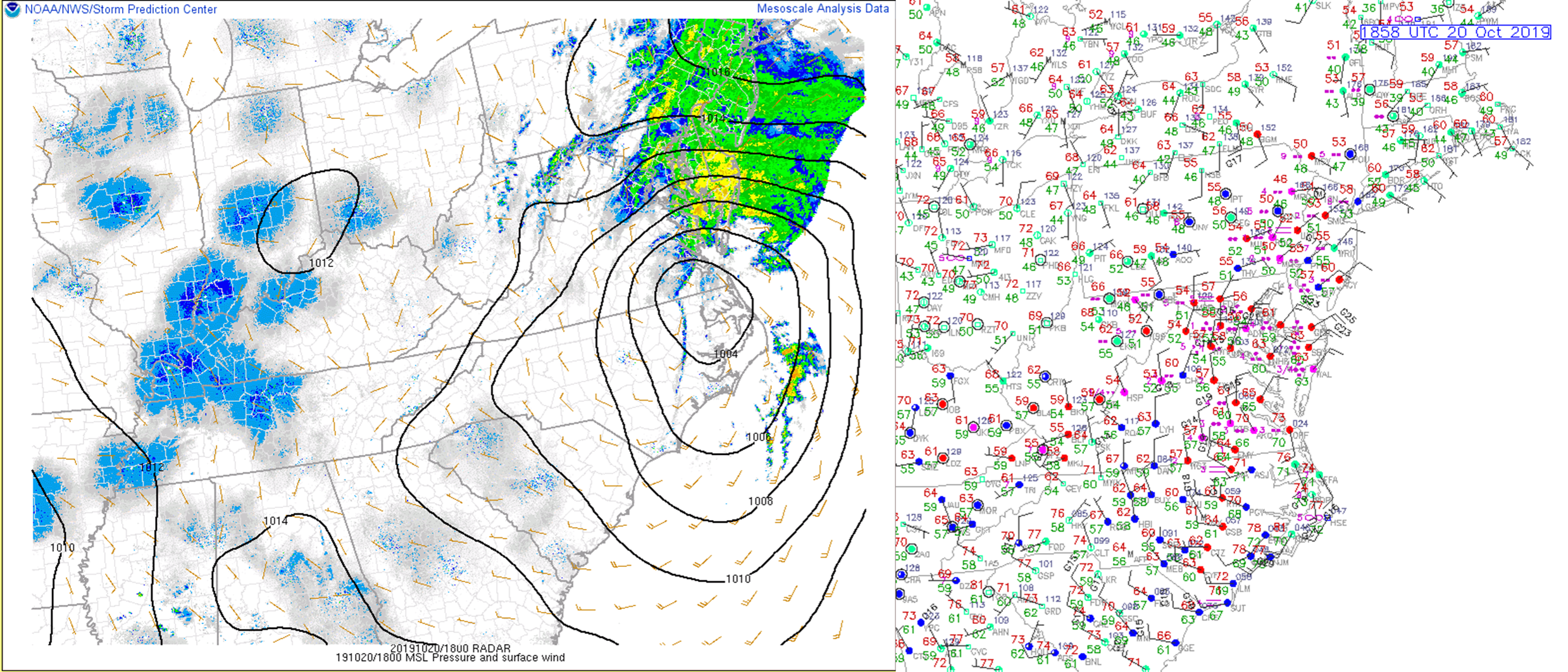 |
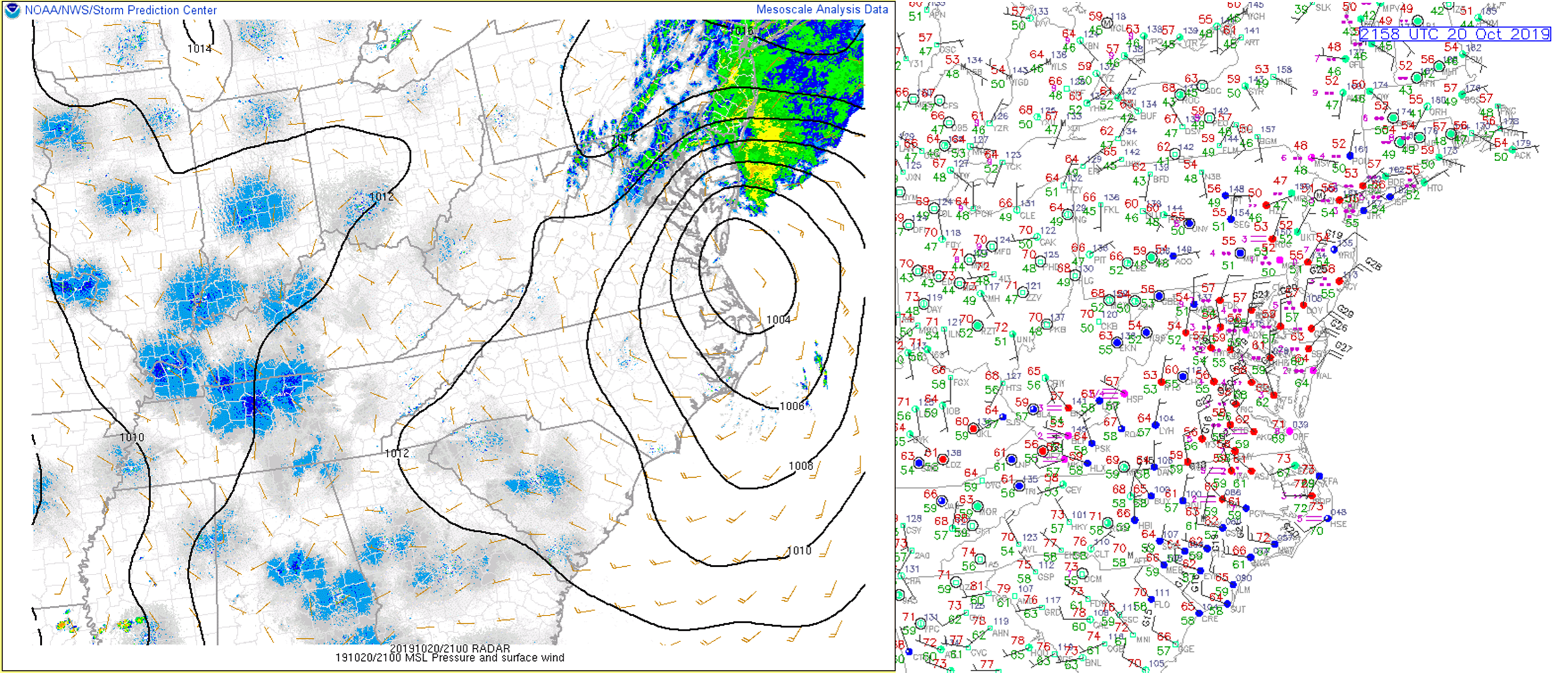 |
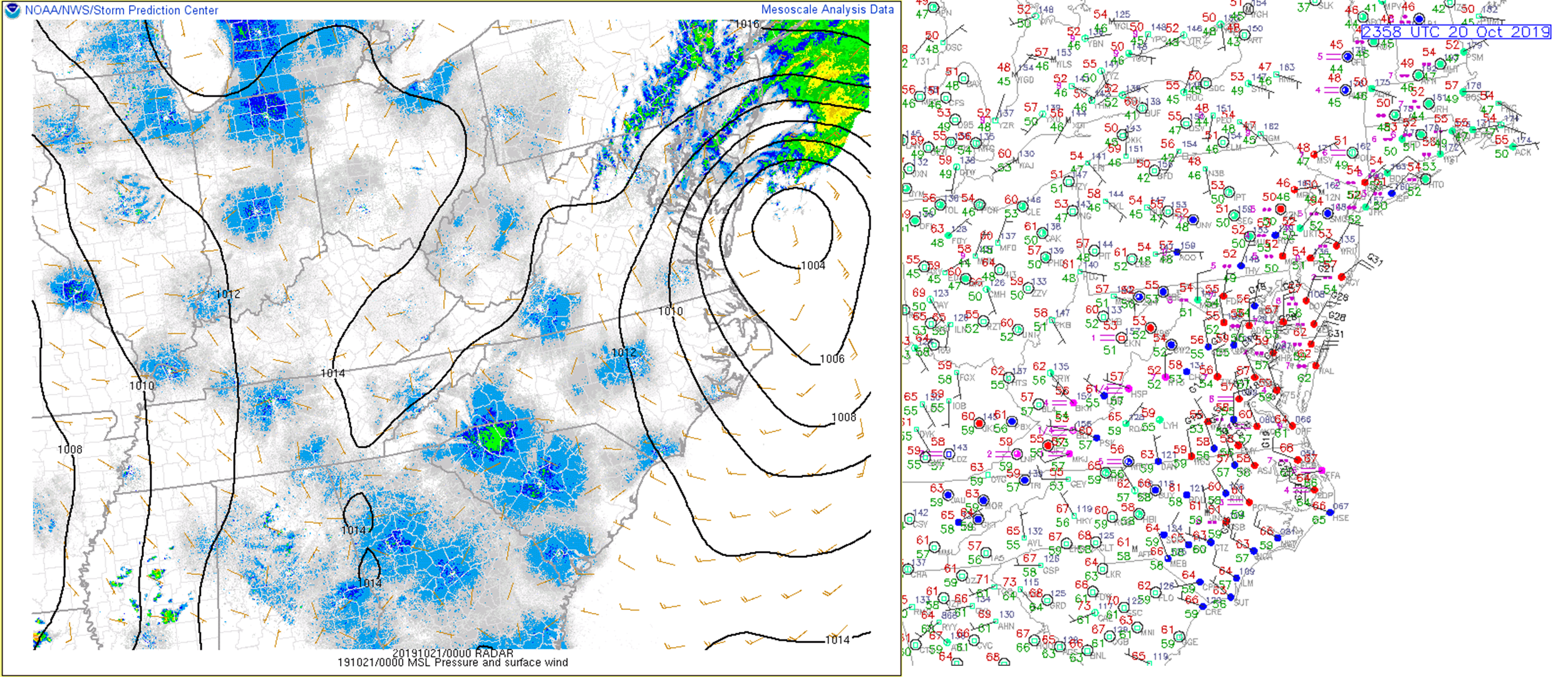 |
| 18z/2 PM 10-20 Surface Analysis + Observations | 21z/5 PM 10-20 Surface Analysis + Observations | 00z 10-21 /8 PM 10-20 Surface Analysis + Observations |
Additional Environmental Data.
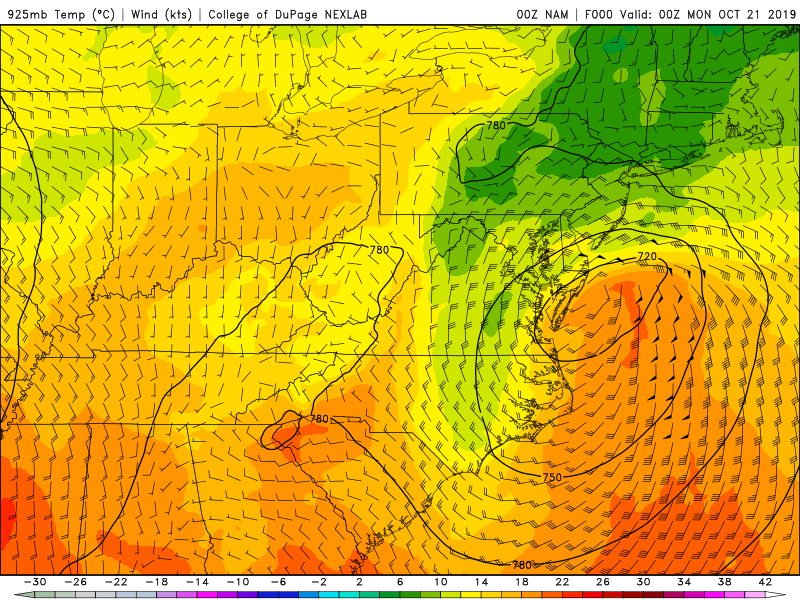 |
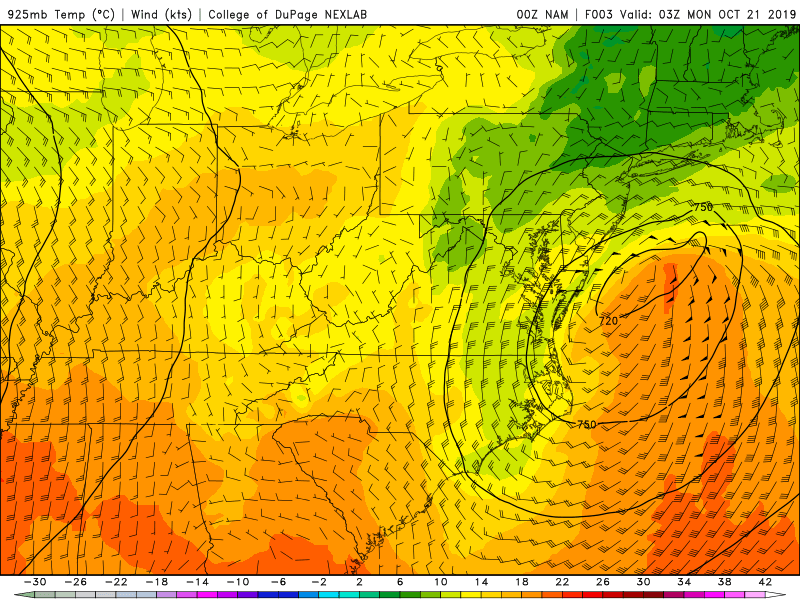 |
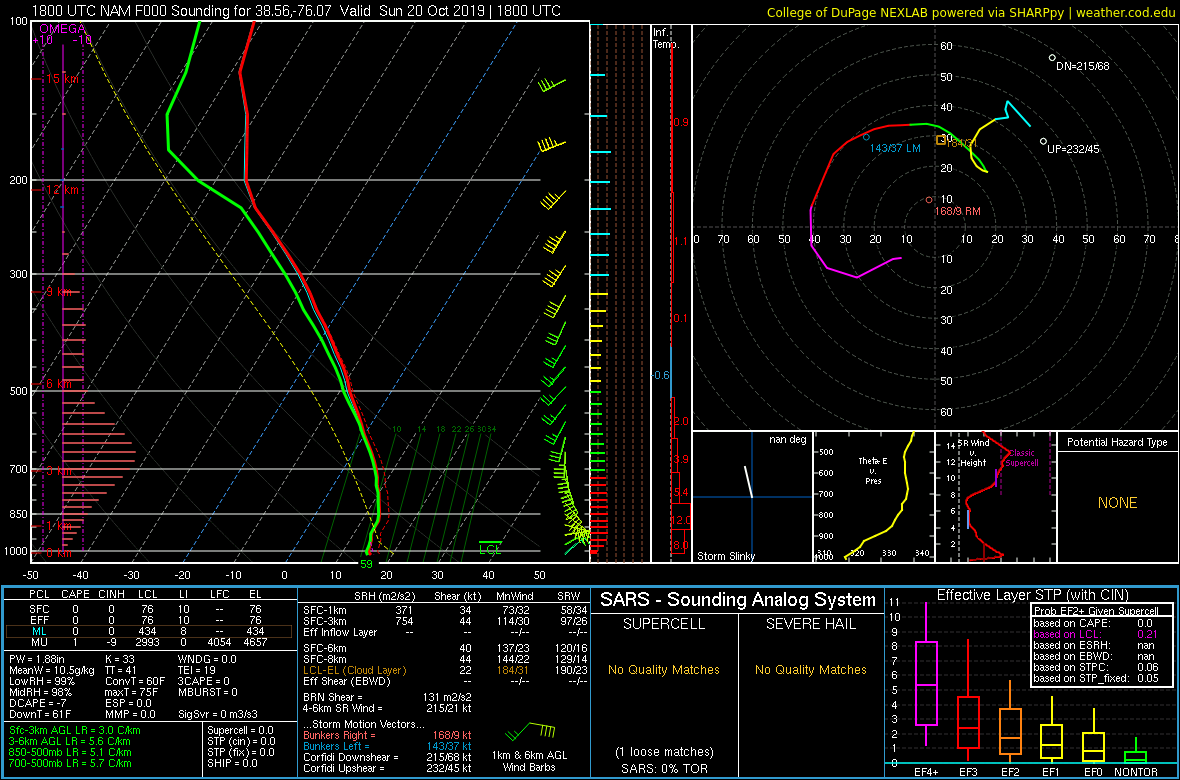 |
 |
| 00z 10-21/8 PM 10-20 925 mb NAM Analysis | 03z 10-21/11 PM 10-20 NAM 925 mb Heights/Winds (3-h forecast) | 18z/2 PM 10-20 NAM Analysis Sounding from Cambridge, MD (Note the high PW values/large warm cloud depth despite surface temperatures of ~60F) | 18z/2 PM 10-20 NAM Analysis Sounding from KMFV (Melfa, VA). Note the PW Value of 2.3 inches, which is > 2 standard deviations above average for mid-late October. |
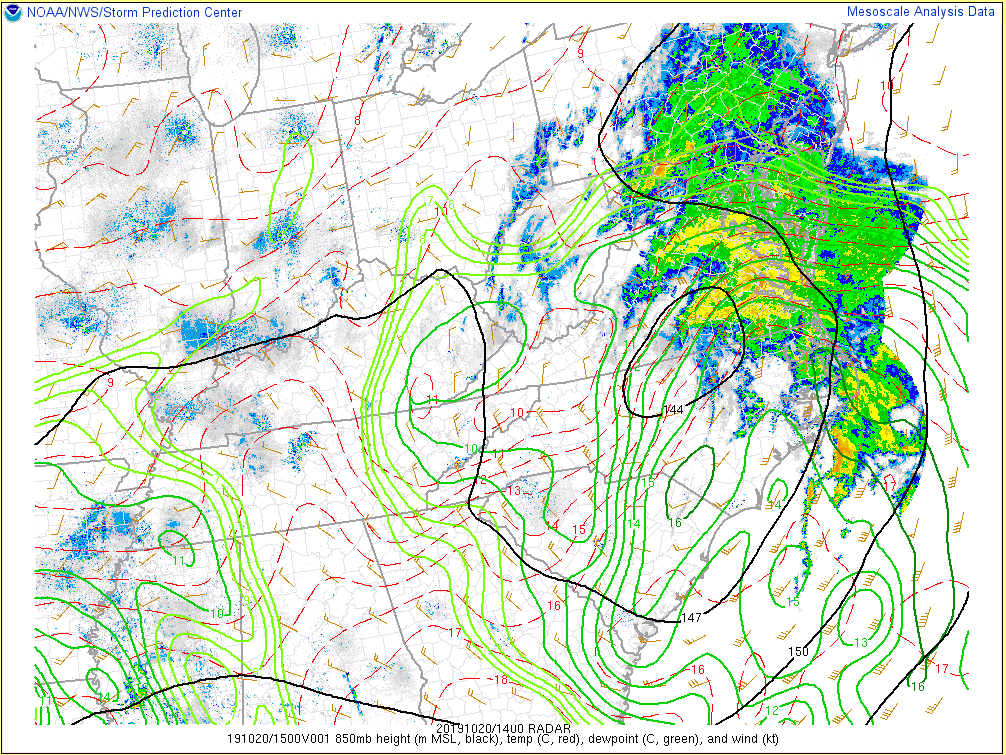 |
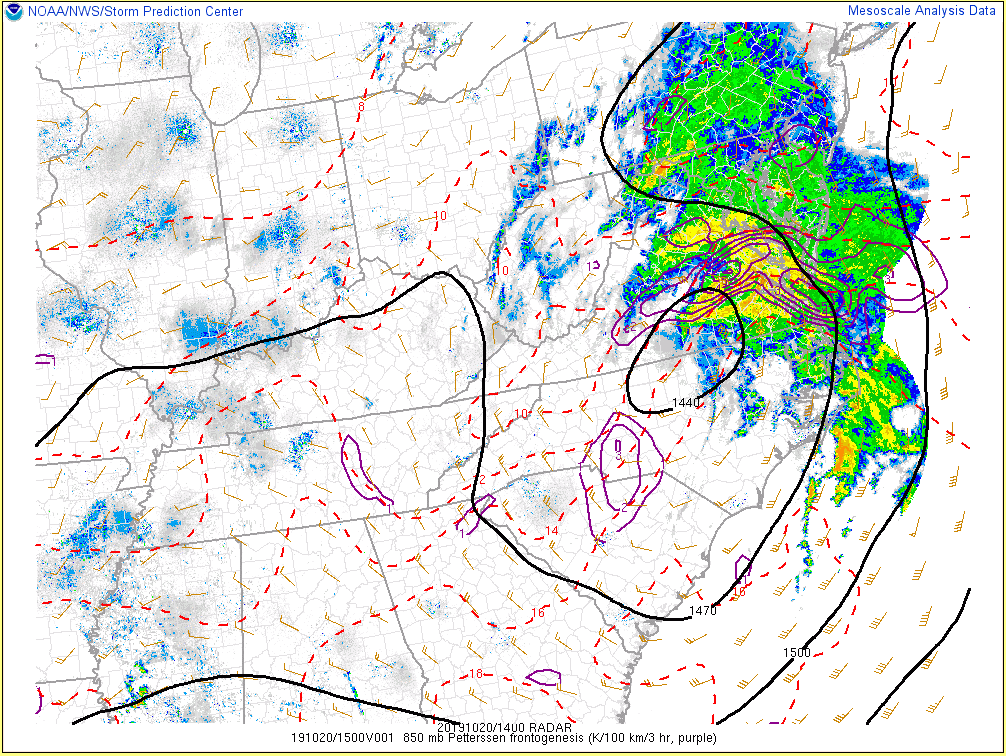 |
| 14z/10 AM 10-20 850 mb Analysis | 14z/10 AM 10-20 850 mb Frontogenesis |
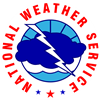 |
Media use of NWS Web News Stories is encouraged! Please acknowledge the NWS as the source of any news information accessed from this site. |
 |